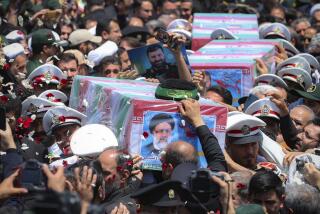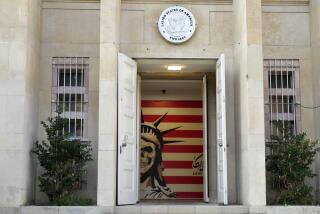Iraqi Holy City Once Home to Khomeini : In Irony of War, He Now Opposes Leader of His Old Host Country
- Share via
NAJAF, Iraq — The holy city of Najaf provides one of the ironies of the Persian Gulf War--for 14 years it was home to Iran’s current spiritual leader, the Ayatollah Ruhollah Khomeini, who now seeks the overthrow of the Iraqi president.
“When he left here, nobody knew he would lead the Islamic revolution in Iran,” said Ismail Abdul-Majid, director of the 300-year-old Imam Ali mosque, which Khomeini visited daily for prayer and meditation.
Najaf, which lies south of Baghdad, the Iraqi capital, has a population of 250,000 and is considered one of Islam’s holiest cities. The Imam Ali mosque houses the gold-encrusted tomb of the Imam Ali, the Prophet Mohammed’s cousin and son-in-law, who is regarded as spiritual founder of the Shia branch of Islam. Shia Muslims are a majority in Iran.
“Khomeini lived here for 14 years, and our leaders took good care of him,” Abdul-Majid said. “He lived in a small house that the government gave him. People did not pay attention to him.”
Khomeini spent much of his exile here before Iran’s 1979 revolution. Today, with the Iraq-Iran war more than five years old, he says there can be no peace unless Iraqi President Saddam Hussein is ousted.
“Even President Hussein welcomed the revolution in Iran. We thought Khomeini would help Iraq, but he took the side of the enemy,” said Abdul-Majid, whose remarks in Arabic were translated by a government official.
Officials would not permit a visit to Khomeini’s former residence or conversation with other Najaf inhabitants.
‘He Drank Our Water’
Asked how the people of Najaf now view Khomeini, Abdul-Majid offered neither praise nor criticism. “He drank our water and ate our food. We are sorry that he left Iraq.”
Abdul-Majid, himself a clergyman who wears the maroon brimless hat and green half-turban of a Shia scholar, insisted that Khomeini never had a following in Najaf, where he headed the theological college.
Khomeini came to Najaf in 1964 from Turkey, to which he had been deported for campaigning against the monarchy of Shah Mohammed Reza Pahlavi.
When the shah began to liberalize politics in the late 1970s and the opposition movement strengthened, Khomeini issued instructions to his followers at home through tape recordings that circulated clandestinely back in Iran.
The Tehran government put pressure on Iraq to stop the flow of anti-shah invective from Najaf, and Khomeini was forced to leave Iraq for France in October, 1978. He made a triumphant return to Tehran on Feb. 1, 1979.
Abdul-Majid said Iraqis reject the fundamentalist Islamic state that Khomeini has established in Iran.
He said the prominence of veiled women clad in long, flowing, black robes is not a sign of fundamentalist pressures within Najaf’s predominantly Shia Muslim population. He described it simply as “a matter of choice.”
“Every man should do what he believes himself. It is not up to me to tell you how to dress or behave.”
Abdul-Majid challenged Khomeini’s motives for continuing the war with Iraq and said the Koran, the holy book of Islam, strictly forbids Muslims to fight each other.
“He says this is a religious war, but it is not,” Abdul-Majid said. “It is a political war, and a religious man does not get involved in politics.”
More to Read
Sign up for Essential California
The most important California stories and recommendations in your inbox every morning.
You may occasionally receive promotional content from the Los Angeles Times.










